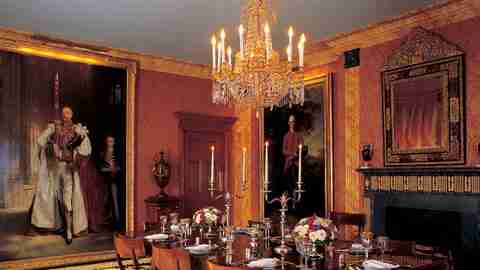View Slideshow

Outrageous luxury is what our clients want," Vincent Fourcade once said, adding, "We have taught them to prefer excess." A grandiloquent statement, certainly, but the grandeur that Fourcade and Robert Denning, his companion and business partner, made into a symbol of American success in the 1980s was a natural outgrowth of his own heritage.
Born in 1934 to a family of distinguished French aesthetes, the designer spent much of his formative years in a twenty-bedroom house replete with made-to-order Majorelle furnishings. He abandoned a career as a banker at twenty-four to become a designer of lavish party décors—for one soiree he and Denning, whom he met in 1959, covered the floor with a hundred old raccoon coats. The dashingly handsome Fourcade segued easily into the role of major decorator, despite his lack of training. "I learned my trade by going out every evening as a young man," Fourcade told the art historian Rosamond Bernier. "I went to every pretty house in France and Italy and other places, too, and I remembered them all, even down to what was on each little table."
What Fourcade seemed to remember most clearly was the staggering luxury of a European family whose taste was sufficiently constant from house to house to lend its name to a style of decoration, le goût Rothschild. Heady interiors that wedded Ottoman luxury to the button-tufted comforts of the Second Empire, the Rothschilds' homes were a constant source of inspiration for Fourcade, even though his projects incorporated ideas and details culled from sources as varied as Carl Larsson watercolors, South Carolina houses and the architecture of the German Neoclassicist Karl Friedrich Schinkel.
It was an opulence that attracted sophisticated clients such as Hélène and Michel David-Weill, Italian politician and Fiat heiress Susanna Agnelli and Françoise and Oscar de la Renta. As often as not, the art was important (Giambologna bronzes, Clodion terra-cottas), the antiques monumental in scale and signed by major cabinetmakers (Adam Weisweiler, Georges Jacob, Thomas Hope), the accessories lavish (Napoleon III carpets, fringed silk lampshades) and the fabrics papal (garnet damask, gas-blue brocade, moodily colored velvets). Balloon shades and fur bed throws were paramount, and always there was a touch of red. A room without it, declared Fourcade, who died in Paris in 1992 at the age of fifty-eight, was like "a woman without lipstick."
An apartment that personified Fourcade's talent for grand-luxe appointments was that of Carolyne Roehm, the fashion designer, and her then husband, financier Henry Kravis. It was also the designer's most controversial creation, so much an emblem of the fortunes made in the 1980s that it reportedly was mimicked in the sets for Sherman McCoy's apartment in the movie Bonfire of the Vanities. When the couple's dining room appeared on the cover of a New York Times Magazine special issue on entertaining, there was a public outcry over the couple's flamboyant lifestyle. The next such issue emphasized instead the joys of make-it-yourself picnics and simple family-style meals—to the great amusement of Fourcade, who rejoiced in his aristocratic approach to life.
